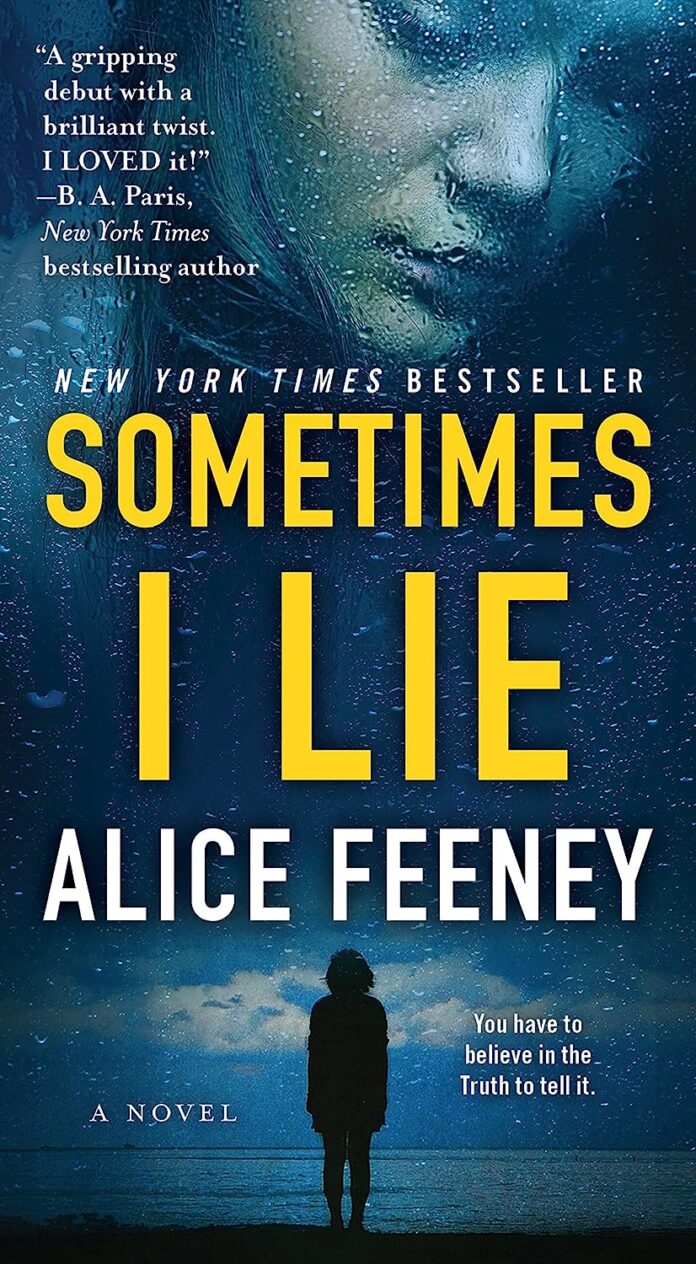in the realm of psychological thrillers, where twists coil like serpents and truths shimmer like mirages, Alice Feeney’s “sometimes I Lie” emerges as a masterclass in narrative deception. “‘” invites readers on a compelling journey through the labyrinth of memory and perception, peeling back the layers of a storyline that challenges the very fabric of reality. As we navigate the murky waters of its protagonist’s consciousness, Feeney crafts a tapestry of intrigue, urgency, and remorse, inviting us to ponder the complexities of honesty and the shadows lurking in the corridors of the mind. This review aims to dissect the novel’s intricate plot,rich character progress,and the profound questions it raises about what we choose to believe—and why. Prepare to embark on an exploration that promises not just to entertain, but also to provoke thought as we unravel the tangled threads of Feeney’s spellbinding narrative.
Exploring the Complex Narrative Structure of Sometimes I Lie
Alice Feeney’s ”Sometimes I Lie” employs a masterful narrative structure that keeps readers guessing at every turn. The story oscillates between a gripping present-day mystery and a collection of memories that reveal the protagonist’s fragmented psyche. This dual-layered approach not only enhances suspense but also immerses the reader in the unreliable nature of memory. The protagonist, lying in a coma, narrates her thoughts amid flashbacks, compelling readers to decipher what is real and what is fabricated. This constant interplay between truth and deception prompts an examination of how personal experiences shape our perception of reality.
To deepen the complexity, Feeney integrates various narrative techniques that further engage the audience. The use of multiple viewpoints and non-linear timelines results in a layered storytelling experience. Key elements include:
- First-person narration: The protagonist’s intimate perspective draws readers closer, amplifying the sense of suspense.
- Flashbacks: These snippets of the past provide crucial context and emotional depth,enriching the current narrative.
- Unreliable narration: As the protagonist’s thoughts unfold, the ambiguity of her truth leads to a calculated tension that keeps readers on edge.
| Element | Function |
|---|---|
| Flashbacks | Provide context and emotional depth |
| Multiple perspectives | enhance complexity and keep readers engaged |
| Unreliable narration | Challenge readers’ trust and perceptions of truth |
This intricate narrative structure not only captivates but also invites readers to ponder the larger implications of truth and deceit. As we navigate through the protagonist’s dizzying reality, we are left to confront our own beliefs about what constitutes truth in our lives, mirroring the personal conflicts that define the core of this compelling tale.
Delving into Unreliable Narrators: A Study of Perception and Deception
Alice Feeney’s Sometimes I Lie captivates readers through its intricate play on the notion of unreliable narration. As we navigate the mind of the protagonist, we are constantly confronted with layers of deception that challenge our perception of truth. The narrative structure intertwines past and present, revealing unsettling twists that blur the line between reality and fantasy. This construction encourages us to question not only the protagonist’s integrity but also our own biases as readers. By placing ourselves in her shoes, we are drawn into a labyrinth of confusion and intrigue; a reflection of our own tendencies to overlook hidden truths and embrace convenient narratives.
Through the protagonist’s fragmented memories and shifting perspectives, the author skillfully explores themes of trust, betrayal, and the fragile nature of memory. Readers are invited to ponder the following questions:
- What motivates the protagonist’s lies?
- How does the perception of other characters influence our understanding of her actions?
- Can we ever truly know someone when even they may not fully understand themselves?
This intricate tapestry of deception not only serves to entertain but also prompts deeper reflection on how we perceive truth in our own lives. By engaging with Feeney’s work, we are reminded of the complexities inherent in human relationships and the narratives we construct around them.
Character Development: The Depths of the Protagonist’s Mind
In Alice Feeney’s “Sometimes I Lie,” the protagonist,Amber Reynolds,serves as a compelling case study in the complexities of character development. As the narrative unfolds through her fractured consciousness, readers are invited to explore a labyrinth of emotions and psychological nuances.Amber’s duality is marked by her ability to manipulate the truth, leading to a deeper understanding of her vulnerabilities and strengths. This complexity is not merely for shock value; it illuminates her humanity, revealing the juxtaposition of her internal struggles against the backdrop of an external world that seems predetermined to judge her. Throughout the novel, we witness her navigate through layers of guilt, trauma, and deception, highlighting the intricate tapestry of human psyche.
The storytelling techniques employed by Feeney further enhance the multidimensionality of Amber’s character. By using varying narrative styles, including journal entries and unreliable recollections, readers gain access to the unfiltered thoughts and emotional turmoil that define her. This method allows for an exploration of thematic elements such as:
- The effects of trauma on self-perception and relationships
- The psychology of deceit and the reasons behind it
- The search for identity in a world filled with chaos
Feeney intricately weaves these themes into Amber’s journey, allowing the audience to empathize with her plight while also questioning the reliability of her perspective. Consequently, readers are not merely passive observers but active participants in deciphering fact from fiction within her mind, creating a compelling dialogue about the nature of truth in storytelling.
Themes of Trust and Betrayal: Uncovering Hidden Motives
The intricate layers of trust and betrayal in Sometimes I Lie serve as the backbone of Alice Feeney’s gripping narrative, weaving a complex web of relationships and hidden motives. The protagonist, Amber, navigates a world where nothing is as it seems, and the reader is invited to peel back the layers of her consciousness to uncover shocking truths. Moments of intimacy between characters often clash with underlying deceit,prompting readers to question the authenticity of every interaction. Trust becomes a fragile façade, as individuals grapple with their own vulnerabilities while concealing darker intentions.
Feeney masterfully illustrates how perceptions are easily manipulated, crafting scenarios that leave both Amber and the audience ensnared in a fog of uncertainty. As betrayals unfold, the stakes escalate, revealing that even the closest bonds are susceptible to distortion.In this emotional labyrinth, readers are left to ponder the motivations behind each character’s actions, whether they stem from fear, love, or revenge. The shifting dynamics foster a sense of paranoia, compelling the audience to scrutinize every confessional monologue and seemingly innocuous dialogue, as buried secrets threaten to surface at any moment.
The Role of Memory and its manipulation in Storytelling
Memory is often portrayed as a steadfast chronicle of our lives, but in Alice Feeney’s “Sometimes I Lie,” it morphs into a fluid, unreliable entity that shapes and distorts the narrative. Characters navigate a landscape where recollections serve dual purposes—both illuminating and obscuring truth. The protagonist’s fragmented memories create a labyrinthine experience for readers, who must decipher what is genuine and what is artifice. This manipulation of memory not only adds depth to character development but also encourages readers to question the very nature of reliability in storytelling. As each memory unfolds, it becomes clear that the past is not a rigid timeline but a tapestry woven with subjective experiences and selective recollections.
By blurring the lines between memory and imagination, Feeney invites her audience to examine the roles these elements play in constructing a narrative. The fluctuating perceptions of the protagonist lead to a deeper exploration of critical themes such as trust, deception, and self-perception. As the plot thickens, the readers are left grappling with unanswered questions and the realization that understanding one’s self is often an intricate dance of memory and emotion. Not only does this exploration enhance the narrative’s complexity, but it also resonates with the readers, leaving them to ponder the following aspects:
- Memory’s Subjectivity: The reliability of memory is called into question.
- Emotional Fabrication: How emotions can reshape memories.
- Plot twists: The unexpected revelations that arise from manipulated memories.
Pacing and Tension: How Feeney keeps Readers on Edge
Alice Feeney’s masterful manipulation of pacing creates an atmosphere thick with tension, compelling readers to devour each page. She expertly crafts her narrative by alternating between timelines, weaving past and present with skillful precision. This strategic pacing keeps readers in a constant state of suspense, as each revelation is meticulously timed to maximize its impact. Feeney employs short, punchy sentences during climactic moments to heighten urgency, while longer, more descriptive passages are reserved for character introspection, allowing readers to connect deeply with the protagonists’ inner turmoil. This rhythm draws readers closer to the unfolding mystery, ensnaring them in a web of uncertainty and anticipation.
The tension escalates further through the use of unreliable narration. Readers are frequently left questioning the truth of what they’ve just read, making them feel like unwilling participants in the protagonist’s psychological labyrinth. Feeney frequently enough employs foreshadowing and dramatic irony, leaving breadcrumbs that lead to both dread and intrigue. As a notable example, seemingly innocuous details blossom into significant clues, sparking readers’ imaginations while keeping them guessing. As they piece together the puzzle, the stakes are steadily raised, ensuring that the culmination of the narrative strikes with lethal force, leaving readers breathless and craving for resolution.
Symbolism and Imagery: Moments that Leave a Lasting Impact
In Alice Feeney’s gripping narrative, symbolism and imagery weave a rich tapestry that echoes the psychological intricacies of its characters. The layered use of colors, weather patterns, and objects reveals intricate themes of deception and truth, inviting readers to delve deeper into the protagonist’s tumultuous psyche. For instance, the frequent references to drowning serve not only as a literal danger but also symbolize the overwhelming nature of the protagonist’s circumstances, mirroring her emotional suffocation. Similarly,the recurring motif of mirrors functions as a dual-edged sword,reflecting both self-perception and the distorted realities that plague her existence,emphasizing the fragmented nature of her truth.
Imagery plays a pivotal role in illuminating key moments throughout the story. The shifting settings—from the ethereal calm of a beach to the claustrophobic confines of a hospital room—act as metaphors for the protagonist’s mental state, transitioning from serene to starkly chaotic. The use of natural elements, particularly shadows and light, enhances the contrast between clarity and obscurity, echoing the novel’s central theme of unreliable narration. To further explore these vivid portrayals, consider the following table that outlines essential symbols and their significance:
| Symbol | Significance |
|---|---|
| Water | Represents emotional depth and danger. |
| Mirrors | Reflect self-perception and distorted truths. |
| Light and Shadows | Contrast between clarity and obscured reality. |
Emotional Resonance: How it Connects with Readers on a Personal Level
one of the standout features of Alice Feeney’s narrative is her ability to tap into the complex tapestry of human experiences, adeptly crafting a connection that resonates deeply with readers. through the protagonist’s tumultuous journey, readers are invited to explore themes of betrayal, loss, and identity. These elements are not just plot devices; rather, they echo the struggles many face in their own lives. Feeney’s poignant prose and vivid imagination compel readers to reflect on their fears and dreams, making the storyline feel almost personal. Key emotional hooks that enrich this experience include:
- Introspection: Characters are layered, prompting readers to analyze their own choices.
- Empathy: The turmoil experienced by the protagonist fosters a sense of shared pain.
- Relatability: Elements of the plot mirror real-life uncertainties and complexities that everyone encounters.
As the story unfolds, the carefully interwoven narrative threads create a sense of urgency and intimacy that keeps readers engaged while also encouraging them to confront their own emotional landscapes.feeney’s use of dual timelines adds another dimension, immersing the reader in a whirlwind of conflicting emotions. The clever juxtaposition of past and present not only serves to build suspense but also deepens the emotional impact of each revelation. Below is a simplified depiction of emotional milestones throughout the narrative:
| Emotional Milestone | Impact on Reader |
|---|---|
| Realization of Betrayal | Heightened tension and a compelling sense of dread. |
| Confrontation with Truth | Invokes introspection and self-evaluation. |
| Acceptance and forgiveness | Offers closure and a nuanced understanding of human flaws. |
Craftsmanship in Prose: Analyzing Feeney’s Unique Writing Style
Alice feeney’s narrative in “Sometimes I Lie” is a masterclass in the art of prose, where every word is meticulously chosen to evoke emotion and set the mood. Her ability to weave intricate layers of suspense allows readers to unravel the complexities of her characters and plot. Through *vivid imagery* and *poignant details*, Feeney crafts an immersive experience that pulls the audience into the mind of her unreliable narrator. This element of psychological complexity transforms a typical thriller into a profound exploration of trust and deception, with each chapter revealing new facets of truth and illusion.
In addition to her compelling storytelling, Feeney employs various stylistic techniques that enhance her narrative voice. Consider the following elements that define her unique approach:
- unreliable Narration: Creates tension and intrigue.
- Non-linear Timeline: Keeps readers guessing.
- Rich Characterization: Evokes empathy and conflict.
- Symbolism: Layers hidden meanings in everyday objects.
These facets contribute to an engaging reading experience, where the text is not merely about what is read but also about what is silenced in between the lines. Readers are left reflecting on the duality of truth,encapsulated beautifully in Feeney’s prose.
Comparative analysis: How This Work Stands Against Modern Thrillers
Alice Feeney’s ”Sometimes I Lie” resonates surprisingly well within the realm of modern thrillers, an arena often dominated by fast-paced narratives and complex plots woven with technological intrigue. Feeney pulls readers into a psychological labyrinth through her protagonist’s unreliable narration, contrasting sharply with the straightforward storytelling typically found in contemporary thrillers. Key elements that set her work apart include:
- Psychological Depth: The exploration of identity and trauma adds layers to the suspense, encouraging readers to ponder the psyche rather than solely chase plot twists.
- Reliability and Deceit: Unlike many contemporary thrillers that lean on overt red herrings, Feeney offers a subtler, more nuanced approach to deception, engaging readers in a game of deduction.
The pacing of “sometimes I Lie” takes a deliberate approach, contrasting with the adrenaline-fueled tempo of many current bestsellers. This slower burn allows for deeper character development and an emotional investment, characteristics often overlooked in many mainstream thrillers. The following table illustrates some differences in key attributes between feeney’s work and popular modern thrillers:
| Attribute | Alice Feeney’s Work | Modern Thrillers |
|---|---|---|
| Character focus | Deep psychological insights | Simplified archetypes |
| Pacing | Deliberate and suspenseful | Fast and action-driven |
| Narrative style | Unreliable narration | Clear-cut perspectives |
Target Audience Insights: Who Will Love Sometimes I Lie
In Alice Feeney’s enthralling novel, the layers of deceit and the intricate psychological web woven throughout ”Sometimes I Lie” will undoubtedly resonate with a specific group of readers. Psychological thriller enthusiasts will be captivated by the twists and turns that challenge their perception of reality. additionally, fans of unreliable narrators will find a special connection with the protagonist, as her intimate struggles and mind games provide an exhilarating reading experience. Literature lovers who appreciate detailed character development and interwoven plotlines will also feel right at home amidst Feeney’s captivating prose.
The book’s appeal extends to those who enjoy thought-provoking narratives that explore themes of truth and memory. Readers who crave stories that make them question the nature of trust and relationships will be drawn into the compelling world Feeney creates. A glance at the expected demographics highlights who might particularly engage with this gripping tale:
| Demographic | Interest |
|---|---|
| age Group | 25-45 years |
| Gender | Predominantly female |
| Reading Preferences | Psychological thrillers and mysteries |
| Common Traits | Curiosity, analytical mindset, and love for plot twists |
critical Reception: What Literary Critics Are Saying About the Book
Alice Feeney’s Sometimes I Lie has garnered a tapestry of critical responses, reflecting its intricate plotting and psychological depth. Critics have particularly praised the author’s ability to weave unreliable narratives, drawing comparisons to iconic storytellers like gillian Flynn and Paula Hawkins. They highlight her deft handling of themes such as deception, trauma, and the complexities of identity, which resonate deeply with readers. Among the standout observations, several literary voices note:
- Masterful Twists: Reviewers are consistently impressed by the unexpected turns that keep them guessing until the final page.
- Complex Characters: Feeney’s portrayal of the protagonist, who lies not only to others but to herself, is deemed a compelling exploration of human nature.
- Emotional Weight: Critics commend the book’s emotional depth, as it delves into issues like memory and psychological strife.
The book’s narrative structure has also been a focal point of discussion. Critics note the skillful transitions between timelines, which create a gripping tension that engages the reader throughout. This structure, paralleled in an array of literary styles, has lead to both admiration and critique, fostering a rich discourse on how narratives unfold in contemporary thrillers.Here’s a snapshot of some of the critical sentiments:
| Critic | Review Highlights |
|---|---|
| The New York Times | “An intoxicating blend of suspense and emotional insight.” |
| BookPage | “A page-turner that forces you to question everything you think you know.” |
| Publishers Weekly | “Feeney brilliantly captures the labyrinth of the mind.” |
Reader Engagement: Discussion Prompts for Book Clubs and Readers’ Groups
engaging with Alice Feeney’s intricate narrative in “Sometimes I Lie” invites readers to peel back layers of deception, trust, and memory. Here are some thought-provoking discussion prompts to stimulate dialogue among book club members:
- Unreliable Narration: How does Feeney’s use of an unreliable narrator impact your perception of the truth throughout the novel?
- Character Choices: What do you think drives the main characters’ decisions, and how do these choices reflect their inner conflicts?
- Thematic Exploration: discuss the themes of perception versus reality. how does this theme manifest in both the characters and the story’s plot?
- personal Reflections: Did you find yourself empathizing with any characters despite their flaws? Why or why not?
To foster deeper conversations, consider breaking down the pivotal moments in the book into a table format, analyzing their significance and the emotional responses they evoke:
| Moment | Emotional Response | Significance |
|---|---|---|
| Revelation of the Truth | Shock | Changes everything we thought we knew about the characters. |
| Key Flashback Scene | Empathy | Provides context for a character’s actions and motivations. |
| final Twist | Confusion | Challenges the reader’s understanding of reality in the narrative. |
Alice Feeney’s Craft: The Journey of a Contemporary Fiction Author
Alice Feeney’s literary prowess is evident in her ability to weave intricate narratives that captivate readers while examining profound themes of truth and deception. In her novel Sometimes I Lie, the skillful manipulation of perspective makes the reader question the reliability of the narrator, allowing Feeney to explore the nuances of memory and reality. Through vivid character portrayals and layered storytelling,she invites her audience into the mind of a protagonist grappling with hidden truths. Key elements that contribute to her craft include:
- Character Depth: Each character is meticulously developed, ensuring that their motivations and backstories resonate.
- Plot Twists: Unexpected turns keep readers on edge, compelling them to reassess their understanding of the narrative.
- Atmospheric Setting: Descriptive settings create an immersive world, enhancing the emotional weight of the story.
Feeney’s journey as a contemporary fiction author reflects a relentless pursuit of authenticity in storytelling. She blends psychological tension with relatable themes, establishing a connection with her readers that goes beyond mere entertainment. Analyzing her work, one can identify recurring motifs, such as:
- Identity Struggles: Characters frequently enough grapple with their sense of self, inviting readers to reflect on their own identities.
- Family Dynamics: Complex relationships add layers to her narratives, making them relatable and engaging.
- the Power of Secrets: The concept of secrets serves as a driving force, propelling the plot and provoking thought.
Final Thoughts
As we draw the curtain on our exploration of “‘,” it’s essential to reflect on the intricate tapestry of intrigue, deception, and revelation woven throughout the narrative. Feeney masterfully entwines her characters’ psyches, beckoning readers to question the very nature of truth and the stories we tell ourselves. This journey through the labyrinth of memory and perception leaves us pondering long after the final page is turned.
In a world where appearances can be misleading and trust is an elusive commodity, Feeney’s work challenges us to look beyond the surface. The depths of her storytelling invite readers to embrace the complexities of human experience—stirring, unsettling, and ultimately transformative. Whether you find yourself laughing, gasping, or contemplating your own truths, the impact of “Sometimes I Lie” lingers like a whisper in the back of your mind, urging you to uncover the deeper layers of your own understanding.
As we close this chapter of our literary adventure, may you carry with you the echoes of Feeney’s truths, unearthing your own as you navigate the ever-shifting landscape of reality. Thank you for joining this deep dive; may your reading journey continue to unravel the beautiful mysteries of life.

















